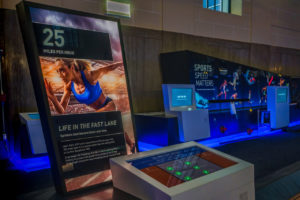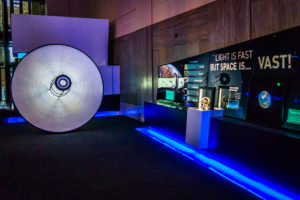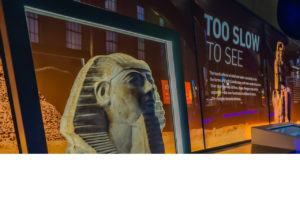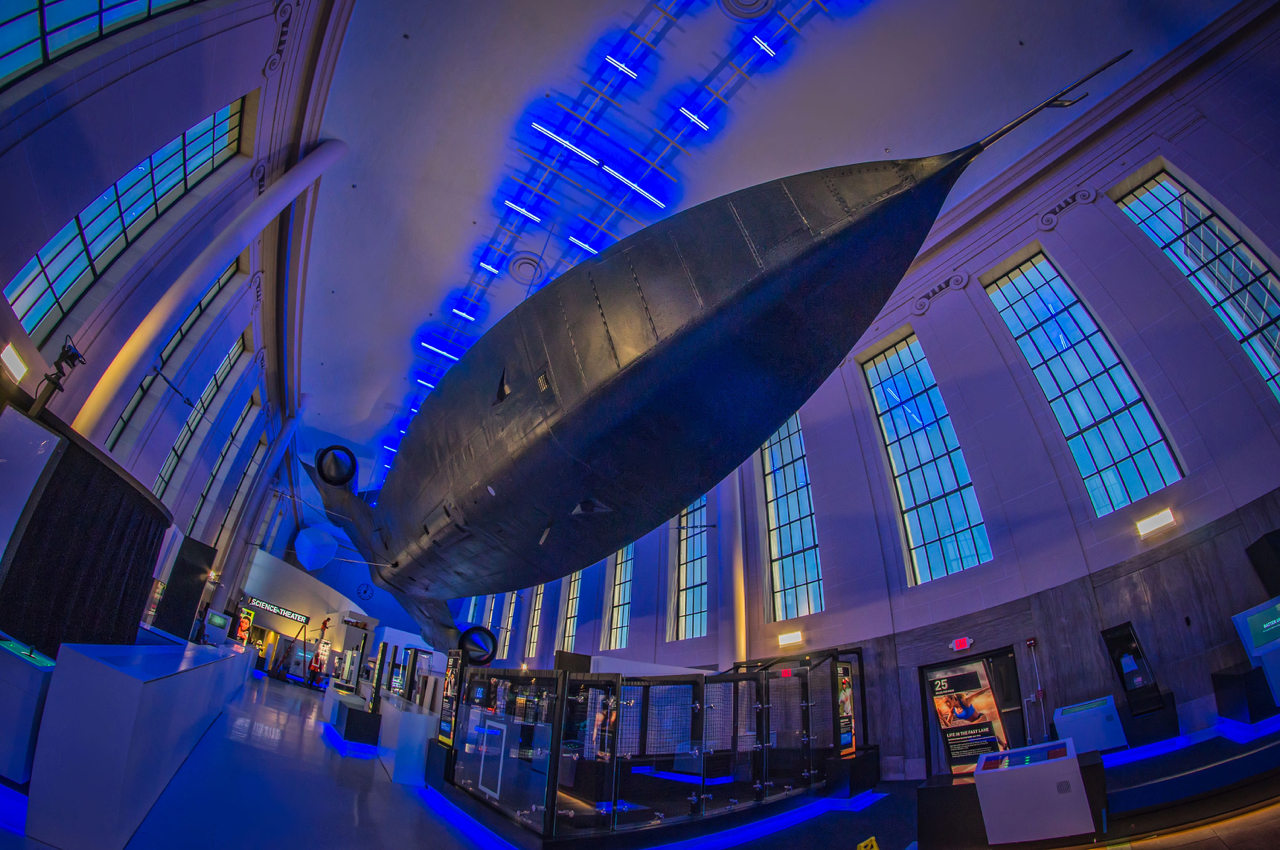Five years in the making, the long-awaited Speed exhibit is open. Was it worth the wait? Billed as the most ambitious exhibit at the Science Museum of Virginia in its 40-year history, it was quite an experience to watch unfold.
In anticipation of the opening, our crew viewed the slow-motion film of the dismantling of the SR-71 supersonic jet from the Virginia Aviation Museum, preparing the exhibit space, installing the jet inside the museum above the impressive 10,000-square foot gallery, and  building up the incredible complementary displays within the exhibit. It is understandable that detailed planning was critical to the success of this astounding exhibit.
building up the incredible complementary displays within the exhibit. It is understandable that detailed planning was critical to the success of this astounding exhibit.
And that planning paid off. At the grand opening, I overheard one visitor marvel at all of the displays, “Wow, there is so much to see!” And everyone in my family would agree with that statement. The mission of the exhibit is to analyze speed in a relevant way across dimensions of light and sound: speed in sports, nature, and industry. The 50-plus displays in this exhibit explore hands-on learning from the super-fast to the painstakingly slow. Try your hand at pitching a fastball, and measure your performance; or race a friend, animal, or Olympic athlete on a sprint track and see how you fare. You can even participate in an interactive light race to examine how fast a human sneeze is compared to a tsunami or the SR-71 supersonic jet.

Have you ever wondered how fast sound travels? At the new Speed exhibit, my personal favorite was the sound dish, where visitors can make a noise near the sound dish and hear the sound wave bounce all the way across the gallery and back to the dish. My husband’s favorite was the Human Wind Tunnel, where visitors can feel the force of forty, sixty, and eighty MPH winds. Standing outside this display for a few minutes, it’s easy to see why this attraction is so popular for all ages, with clothes flapping in the wind and hair surrounding your head like a mop. When one man’s glasses flew off, his wife frantically yelled through the glass, “Don’t step on them! Your glasses!” (Everything turned out fine as he quickly picked up his glasses on the way out of the display). After my turn in the wind tunnel, my 8-year-old told me, “Mommy, you just got a bad hair day!” Yes, indeed.
 Watching slow-motion videos of birds flapping their wings, a water balloon popping, or a water droplet falling demonstrates how so many things are over in the blink of an eye, and too fast to see in real time. A fan favorite was also learning about how germs can travel over time, as my 8-year-old almost gleefully exclaimed, “That is so gross!” (I’m hoping one of the indirect benefits of learning this is more diligent hand washing.)
Watching slow-motion videos of birds flapping their wings, a water balloon popping, or a water droplet falling demonstrates how so many things are over in the blink of an eye, and too fast to see in real time. A fan favorite was also learning about how germs can travel over time, as my 8-year-old almost gleefully exclaimed, “That is so gross!” (I’m hoping one of the indirect benefits of learning this is more diligent hand washing.)
On the other end of the spectrum, exhibits also highlight phenomena that are too slow to see, such as tree growth and erosion. Another popular display lets visitors watch the  time-lapse videos of the James River over the course of a year, moving through each season, or a time-lapse video of visitors coming into the museum. Can you find your posse on camera as you walked in moments before?
time-lapse videos of the James River over the course of a year, moving through each season, or a time-lapse video of visitors coming into the museum. Can you find your posse on camera as you walked in moments before?
My 10-year old enjoyed the jet the most, which as the focal point of the exhibit hangs over the Speed gallery. One visitor commented, “I didn’t realize it was so big!” The legendary SR-71 Blackbird spy plane from the Cold War is massive, measuring 55 feet wide and 107 feet long. As displayed, it weighs 43,000 pounds, and if it were stocked with fuel and engines, it would weigh 100,000 pounds. That is a lot of titanium alloy! No wonder it took so much planning to make this exhibit happen. It is the only SR-71 ever to be suspended from a ceiling. This plane is capable of capturing an image of a license plate while traveling 2,000 mph and over fifteen miles above ground. Traveling faster than Mach 3 (three times the speed of sound), the jet can travel the United States coast to coast in a little over an hour.
The layout and design of the gallery itself offers more good news for museum guests. Even at busy times, the exhibit space accommodates many people without feeling crowded. Even though there may be a few lines to try out different exhibits, they move fast. And with the SR-71 Blackbird overhead, the incidence of visitors looking up (yes, rather than down at their phones) should be increased.
And the answer to my original question? Yes, Virginia, it was worth the wait. So sprint, bike, or drive over to the Science Museum of Virginia to experience Speed, the museum’s newest permanent exhibition.
Speed is included with admission. The Science Museum of Virginia admission is $14 for adults with a $1 discount for youth and seniors. Children three and under are admitted free with a paid adult. Active military receive free admission to exhibits. For more information, or to purchase your family membership, visit SMV.org or call 804.864.1400.







